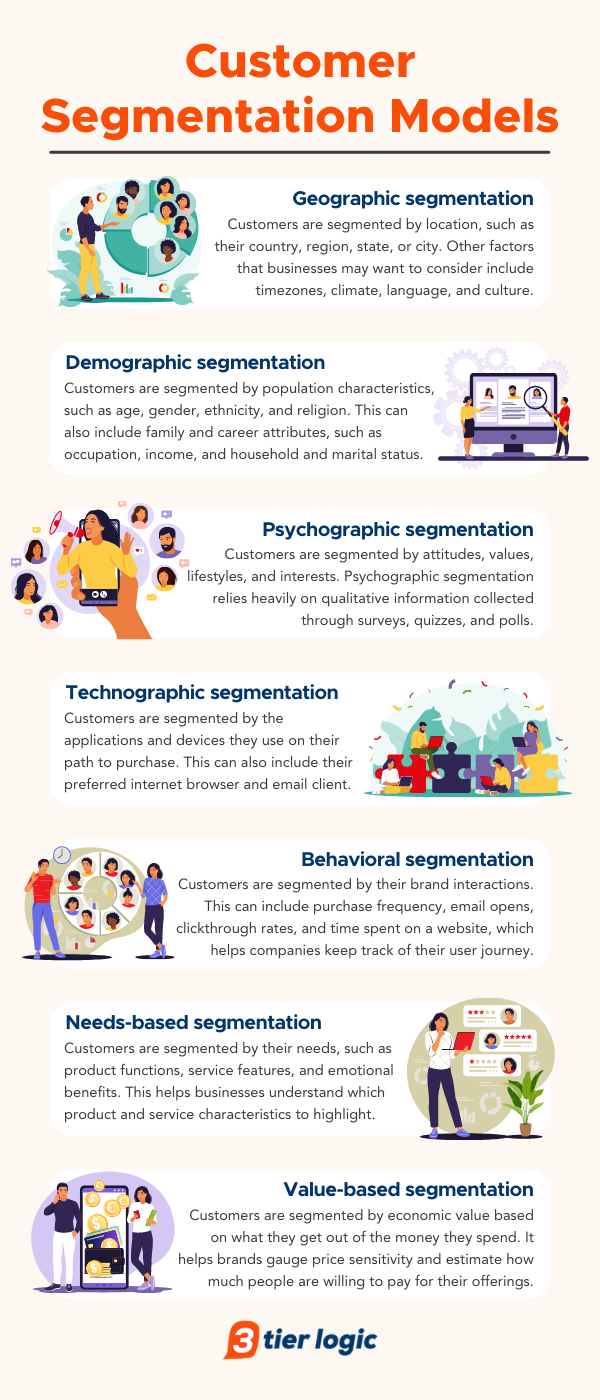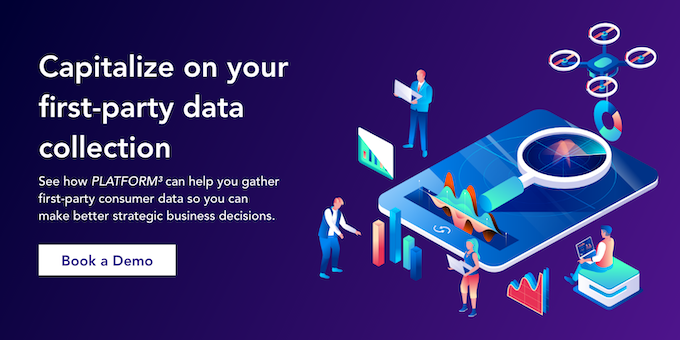Importance of Customer Segmentation
Communicating and connecting with people, especially in marketing, is all about understanding their needs, behaviors, and expectations. Rather than looking at their potential and existing customers as a collective whole, businesses should take the time to understand them as individuals with unique perspectives. For example, why do some customers value quality over price? Why do some customers prefer to shop in-store instead of online? Why do some customers purchase your products once a month, while others only engage with your brand twice a year?
To answer these questions, companies should segment their users by shared similarities in order to establish, nurture, and maintain strong relationships. When they conduct market research and data collection to categorize their customers, they can better understand how to position themselves in their industry, personalize their marketing efforts, and meet shopper expectations. What is customer segmentation, and how does it work?
What is customer segmentation?
Customer segmentation is the process of separating customers into groups based on common similarities and characteristics. This can range from geographic and demographic factors, such as age, location, and income, to psychographic and behavioral factors, such as what motivates them to shop and how they prefer to shop. Customers are categorized using market research, industry and competitor analysis, and customer data. When capturing user information, companies should focus on zero-party and first-party data, which includes their contact information, purchase history, marketing communication preferences, and survey responses.
Segmentation helps businesses customize their marketing strategies to provide shoppers with the brand experiences they’re looking for. This can range from sending targeted email campaigns to designing in-store displays to serving personalized digital ads. As a result, customers feel more connected and engaged. Personalization can lead to customer loyalty and brand advocacy, especially when companies nurture the business-consumer relationship in the right ways.
Benefits of customer segmentation
Drives conversions and sales
When companies take the time to understand and fulfill their customers’ individual needs, shoppers are more likely to engage with their brand. This might mean opening an email where the subject line mentions a sale they’re interested in or clicking a banner ad for a product they were thinking of buying. Naturally, these actions can eventually lead to product purchasing. Customer segmentation puts the right information in front of the right audiences, increasing awareness, engagement, and sales.
Reduces risks and costs
Segmentation reduces the risk of losing customers, users, and followers because it helps businesses give shoppers what they’re looking for. For example, when companies send a generic email campaign about an upcoming sale, people may unsubscribe because the content isn’t tailored to their needs or interests. However, if brands send personalized email campaigns about the same sale that highlight consumers’ favorite products, they’re more likely to express interest and engage. When businesses retain users through segmentation, their customer acquisition costs (CAC) decreases while their return on investment (ROI) increases, resulting in higher profitability and customer lifetime value.
Improves customer service and brand experiences
Companies often segment users by their marketing and communication preferences, such as what kind of emails they want to receive or what types of product recommendations they want to see. This can also extend to other types of user touchpoints, such as customer support, social media interactions, and in-store experiences. For example, some users may prefer the convenience of chatbots and automated processes, while others prefer interacting with a real person. Customer segmentation allows brands to give shoppers not only the products they want, but also the service and experiences they’re looking for.
Identifies opportunities and challenges
Segmentation helps brands discover where they can grow and how they can improve from a customer perspective. They might find that a specific consumer demographic prefers a social platform they’re not currently on, or that customers who prioritize value think their prices are too high for what’s being offered. Their app users may be less likely to complete a transaction than their website users because the interface is confusing, while shoppers of a certain age group might be talking about a competitor’s latest product features. Brands that leverage segmentation to understand their customers’ unique journeys are better equipped to identify possibilities and limitations.
Creates committed relationships and engaged communities
When brands segment customers by common characteristics, they’re building user profiles that can inform their personalization strategies. This may include targeted email campaigns, personalized recommendations, and exclusive offers and experiences. Personalization often turns initial shoppers into repeat customers and brand advocates, as brands are nurturing and solidifying the business-consumer relationship through trust, commitment, and reciprocity. Segmentation and personalization also leads to engaged brand communities, as like-minded users may seek each other out to connect over shared interests. Some examples include comment sections, discussion forums, Facebook groups, and in-person meetups.
Challenges of customer segmentation
Data quality and management
Data collection processes for customer segmentation are typically complex and prone to inaccuracy, inconsistency, and incompleteness. Brands need to fully commit to the proper organization and maintenance of their data so it’s useful and meaningful. They should also focus on capturing zero-party and first-party data, rather than second-party and third-party data, as the latter two may vary in quality, relevance, and trustworthiness. Businesses should also ensure that their customer segments are clearly defined, easily understood, and simple to incorporate into their current and future strategies. They need to invest in data management and analytics tools that integrate with their existing systems and keep their information clean and standardized.
Relevance and timeliness
One common fallacy of customer segmentation is creating segments that are unrelated, too small, or overly specific. These kinds of groups can be a waste of time and resources, as they aren’t relevant or quantifiable enough to hold any buying power or customer lifetime value. Brands should also caution against creating user segments that are out-of-date or based on outdated information. For example, when designing a summer marketing campaign, they should look at customer data from the previous year’s summer campaign, not the one from five years ago. When segmenting shoppers by social media platform usage, they should ask themselves if including sites like Google+ and Vine is necessary.
Agility and scalability
When creating their initial user categories, businesses need to account for flexibility and future expansion. Otherwise, they risk getting stuck with set decision-making processes or planning methods. Brands should stay open to changes in their customer and market segments, such as splitting them, combining them, or even getting rid of them if they become obsolete. They also need to be able to quickly adjust their segments according to changes in industry regulations and market trends. Companies should prepare to scale their customer segmentation efforts as well, especially if they’re looking to grow at an accelerated pace.
Customer segmentation models
Geographic segmentation
In geographic segmentation, customers are primarily categorized by location, such as their country, region, state, or city. Other geographic factors that businesses may want to consider include timezones, climate, language, and culture. For example, American footwear companies might sell different types of shoes to customers in Texas compared to customers in Oregon because of their opposing weather conditions. Multinational food brands may use different packaging in Asia than they do in North America due to varying cultural attitudes towards food and food advertising.
Demographic segmentation
In demographic segmentation, customers are primarily categorized by population characteristics, such as age, gender, ethnicity, and religion. This can also include family and career attributes, such as occupation, income, and household and marital status. For example, car manufacturers might market their cheapest model to teenagers saving up to buy their first car or market their model with the most safety features to parents of young children. Depending on which age group or generation their customers belong to, businesses may choose to focus their efforts on email campaigns, social media marketing, or store advertising.
Psychographic segmentation
In psychographic segmentation, customers are primarily categorized by attitudes, values, lifestyles, and interests. As psychographic segmentation relies heavily on qualitative information, brands need to focus on capturing zero-party data through surveys, quizzes, and polls to understand consumer preferences and motivations. For example, snack brands can ask shoppers about their favorite chip flavors, while software companies can ask users what features they’d like to see in future updates. When used in combination with other segmentation models, psychographic segmentation can help businesses create detailed buyer personas and in turn, design personalized marketing campaigns.
Technographic segmentation
In technographic segmentation, customers are primarily categorized by the applications and devices they use on their path to purchase. This can include what internet browser people use to visit company websites, what email application they use to open marketing communications, and what device they use to complete their purchases. Brands should use technographic segmentation to understand and optimize their consumers’ experience across all platforms and devices. For example, they might discover that a number of users are dropping out before the purchase stage of their buyer journey because of a checkout issue on their website.
Behavioral segmentation
In behavioral segmentation, customers are primarily categorized by their brand interactions. This can include purchase frequency, email opens, clickthrough rates, and time spent on a website. Behavioral segmentation especially helps companies understand their users’ journeys, reduce friction, and identify up-selling and cross-selling opportunities. For example, they can send reminder emails to users with abandoned carts or offer related product recommendations once users make a purchase. Businesses can use first-party data, such as website registrations, purchase history, and customer feedback to inform their behavioral segmentation strategies.
Needs-based segmentation
In needs-based segmentation, customers are primarily categorized by their needs, such as product functions, service features, and emotional benefits. For example, furniture brands may want to market their products as easy to assemble, easy to store, or easy to clean. Grocery delivery apps should inform customers if they have a flexible cancellation policy or convenient options for recurring items. Lastly, businesses can evoke certain emotions or set a certain tone to engage customers, such as a restaurant whose food tastes like home cooking or travel agencies who specialize in memorable experience packages.
Value-based segmentation
In value-based segmentation, customers are primarily categorized by economic value based on what they get out of the money they spend. Value-based segmentation helps businesses gauge price sensitivity and estimate how much people are willing to pay for their products and services. It also helps them determine the value of their customers themselves. Customer lifetime value, the monetary amount consumers are estimated to bring to your business, can be leveraged to increase profitability and reduce costs. When combined with other segmentation models, value-based segmentation identifies when, where, why, and how people spend the way that they do.
How to leverage customer segmentation
Brands can segment customers in a number of different ways to help drive sales, identify opportunities, reduce risks, and grow their business. When companies capture and leverage market research and first-party data, their strategies and decision-making processes become stronger as a result. Segmentation also supports personalization, creating a more engaged customer base.
3 tier logic’s PLATFORM³ helps brands connect with customers and collect valuable first-party data through gift with purchase promotions, contests and sweepstakes, loyalty programs, and more. The Data Capture & Analytics dashboard provides consumer insights into how to improve awareness, increase engagement, and nurture customer loyalty. To learn more, book a demo with our team today.



